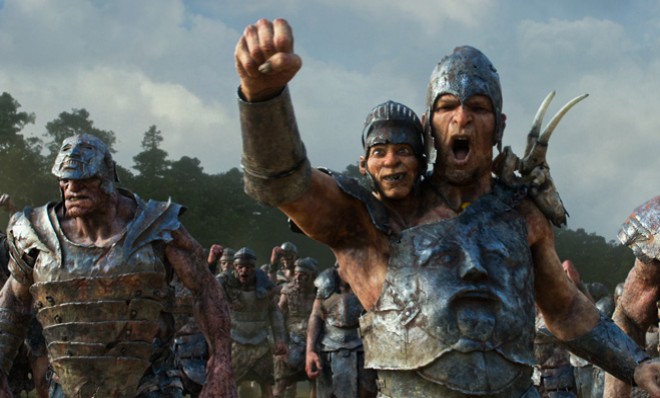Where did Jack the Giant Slayer go wrong?
The film, which began production in January 2009, is expected to gross just $25 million on a $300 million budget when it hits theaters Friday


Though Oscar season ended less than a week ago, Hollywood is eager for blockbuster season to begin, and Friday sees the release of Jack the Giant Slayer — the first mega-budget studio film to grace movie screens in 2013. (Watch a trailer below.) But early signs indicate that Warner Bros. shouldn't anticipate a blockbuster-sized return on its investment. According to The Hollywood Reporter, the studio spent nearly $300 million to make and market Jack the Giant Slayer, and head of domestic distribution Dan Fellman predicts an opening weekend of around $30 million — an estimate that many believe is too high.
It's possible, and maybe even probable, that Jack the Giant Slayer will follow the path of many recent blockbusters by making up for a poor domestic gross with a disproportionately massive gross overseas, where the appetite for Hollywood blockbusters has never been larger. But whatever the movie's ultimate gross turns out to be, the long, troubled production process for Jack the Giant Slayer is a fascinating case study of the process of making a modern Hollywood blockbuster — and the countless pitfalls that can pop up along the way.
Jack the Giant Killer — what the film was originally called — began pre-production in January 2009, when Warner Bros. hired director D.J. Caruso, who had filmed Shia LaBeouf in back-to-back hits Disturbia and Eagle Eye. The studio had high hopes for the film, which was greenlit in the midst of Hollywood's mad rush for all-ages fairy tales like Alice in Wonderland and Snow White & the Huntsman. But less than a year after Caruso was announced as Jack the Giant Killer's director, he was replaced in September 2009 — Warner Bros. gave minimal explanation — by Bryan Singer. When Singer signed on, he took immediate steps to make the project his own. In a 2011 interview with IGN, Singer revealed that frequent collaborator Christopher McQuarrie "did a significant rewrite" on the original script that resulted in both "a different structure" and "a different storyline" for the film. In the midst of development, the film's start date was pushed back from summer 2010 to February 2011 so Singer could "pre-visualize scenes with the digital giants" and work out the complexities of the film's cutting-edge technology. At the time, the list of actors being considered for the film's title role included The Amazing Spider-Man's Andrew Garfield and Anna Karenina's Aaron Johnson. (Warm Bodies star Nicholas Hoult was eventually cast.)
The Week
Escape your echo chamber. Get the facts behind the news, plus analysis from multiple perspectives.

Sign up for The Week's Free Newsletters
From our morning news briefing to a weekly Good News Newsletter, get the best of The Week delivered directly to your inbox.
From our morning news briefing to a weekly Good News Newsletter, get the best of The Week delivered directly to your inbox.
Jack the Giant Killer had come about at a pivotal point in Singer's career. After breaking into the mainstream with surprise hit The Usual Suspects in 1995, he helped kick off the superhero blockbuster craze when he helmed the first two X-Men movies, which were warmly received by both fans and critics. But Singer's fortunes turned when he left the X-Men series to direct Superman Returns, a passion project that failed to reinvigorate the franchise (and eventually necessitated a reboot in the form of this summer's Zack Snyder-directed Man of Steel). Since then, Snyder's career has been far more eclectic. Though he continued to serve as an executive producer on Fox's megahit drama series House, his more recent directorial efforts have been middling at best. The Tom Cruise-starring historical drama Valkyrie earned indifferent reviews and a so-so domestic gross, and Singer's two attempts to kick-start another TV show — ABC's Football Wives and NBC's Mockingbird Lane, proposed as a reboot of the The Munsters — failed to make it to series. (Given recent history, it's no great surprise that Singer's next project is X-Men: Days of Future Past — a return to the franchise that made him a top-tier director in the first place.)
However much a boon Jack the Giant Killer was for Singer's career, the movie continued to be plagued by delays. The film was originally scheduled for a plum June 2012 release, which would have placed it in the the midst of the summer blockbuster season — but several months before the release date, Warner Bros. announced that the film would be pushed back to March 2013 because of difficulties completing its complex visual effects. But according to The Hollywood Reporter, Singer's problems were about more than just effects. The general consensus seems to be that "the tone of the movie wasn't hitting the mark," with one insider a reporting that another reason for the delay was a series of reshoots prompted by concerns that Jack the Giant Killer was "too fanboy and not enough family."
And then there was the title. Marketing a family-oriented movie with "Killer" in its name was never going to be easy, even if giants were the only ones being killed. In October, Warner Bros. decided to rebrand the film as the marginally softer Jack the Giant Slayer. "It happened after the Colorado tragedy," explains Singer in an interview at The Huffington Post. "I really think there was a concern that the word 'killer' is a very contemporary word for 'murderer.' And 'slayer' is a mythic expression: one slays giants, one slays dragons." Maybe so — but it's also created a branding problem for the movie, which was known as Jack the Giant Killer for more than two years. The detritus of posters and trailers labeled Jack the Giant Killer are still scattered across the internet.
As it finally hits theaters more than four years after it was originally announced, Jack the Giant Slayer has a tough road ahead of it. One week after it debuts, Disney is set to release Oz the Great and Powerful — a fantasy film, similar in scope and target audience, that also benefits from its association with the original Wizard of Oz. Singer's movie has the more difficult task of convincing audiences to see an unfamiliar, untested fantasy film during the first week of its release — and, in the weeks to come, the far more difficult task of convincing them to see it instead of Oz the Great and Powerful.
A free daily email with the biggest news stories of the day – and the best features from TheWeek.com
The irony is that for all rumblings and rumors that beset its extended production, Jack the Giant Slayer has been fairly well-received by the critics who've seen it. Though only 14 reviews have been filed at Rotten Tomatoes, 10 of them are positive; The Village Voice's Scott Foundas compares the film to 1963's fantasy classic Jason and the Argonauts, and The Hollywood Reporter's Todd McCarthy says it's "markedly superior" to December's The Hobbit: An Unexpected Journey, which has grossed nearly $1 billion worldwide. Jack the Giant Slayer may still manage to beat the odds and become the hit Warner Bros. clearly expected it to be more than four years ago — but that's an awfully tall beanstalk to climb.
Scott Meslow is the entertainment editor for TheWeek.com. He has written about film and television at publications including The Atlantic, POLITICO Magazine, and Vulture.



